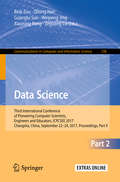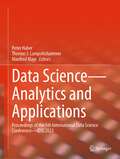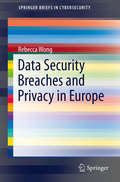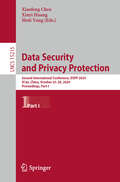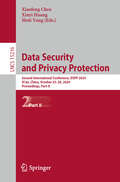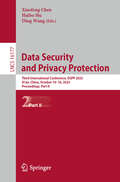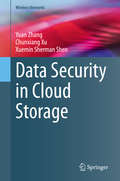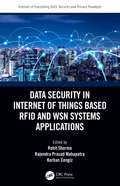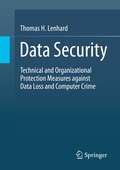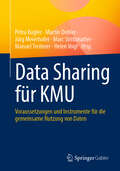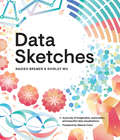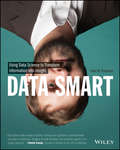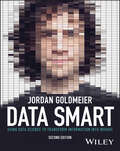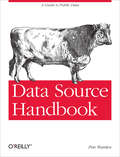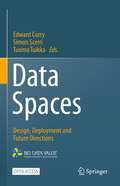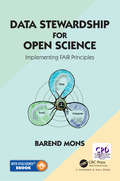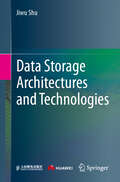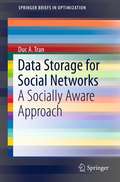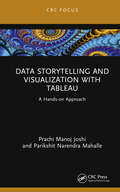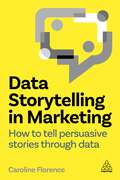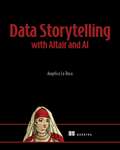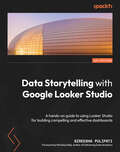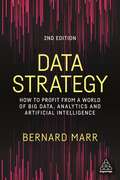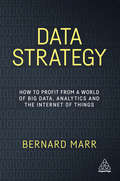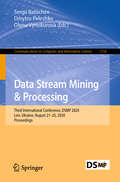- Table View
- List View
Data Science: Third International Conference of Pioneering Computer Scientists, Engineers and Educators, ICPCSEE 2017, Changsha, China, September 22–24, 2017, Proceedings, Part II (Communications in Computer and Information Science #728)
by Qilong Han Weipeng Jing Guanglu Sun Zeguang Lu Beiji Zou Xiaoning PengThis bookconstitutes the refereed proceedings of the First National Conference on BigData Technology and Applications, BDTA 2015, held in Harbin, China, in December2015. The 26revised papers presented were carefully reviewed and selected from numeroussubmissions. The papers address issues such as the storage technology of Big Data;analysis of Big Data and data mining; visualization of Big Data; the parallelcomputing framework under Big Data; the architecture and basic theory of BigData; collection and preprocessing of Big Data; innovative applications in someareas, such as internet of things and cloud computing.
Data Science—Analytics and Applications: Proceedings of the 5th International Data Science Conference—iDSC2023
by Peter Haber Manfred Mayr Thomas J. LampoltshammerBased on the overall digitalization in all spheres of our lives, Data Science and Artificial Intelligence (AI) are nowadays cornerstones for innovation, problem solutions, and business transformation. Data, whether structured or unstructured, numerical, textual, or audiovisual, put in context with other data or analyzed and processed by smart algorithms, are the basis for intelligent concepts and practical solutions. These solutions address many application areas such as Industry 4.0, the Internet of Things (IoT), smart cities, smart energy generation, and distribution, and environmental management. Innovation dynamics and business opportunities for effective solutions for the essential societal, environmental, or health challenges, are enabled and driven by modern data science approaches.However, Data Science and Artificial Intelligence are forming a new field that needs attention and focused research. Effective data science is only achieved in a broad and diverse discourse – when data science experts cooperate tightly with application domain experts and scientists exchange views and methods with engineers and business experts. Thus, the 5th International Data Science Conference (iDSC 2023) brings together researchers, scientists, business experts, and practitioners to discuss new approaches, methods, and tools made possible by data science.
Data Security Breaches and Privacy in Europe (SpringerBriefs in Cybersecurity)
by Rebecca WongData Security Breaches and Privacy in Europe aims to consider data protection and cybersecurity issues; more specifically, it aims to provide a fruitful discussion on data security breaches. A detailed analysis of the European Data Protection framework will be examined. In particular, the Data Protection Directive 95/45/EC, the Directive on Privacy and Electronic Communications and the proposed changes under the Data Protection Regulation (data breach notifications) and its implications are considered. This is followed by an examination of the Directive on Attacks against information systems and a discussion of the proposed Cybersecurity Directive, considering its shortcomings and its effects. The author concludes by looking at whether a balance can be drawn by the current and proposed Data Protection framework to protect against data security breaches and considers what more needs to be achieved.
Data Security and Privacy Protection: Second International Conference, DSPP 2024, Xi'an, China, October 25–28, 2024, Proceedings, Part I (Lecture Notes in Computer Science #15215)
by Moti Yung Xinyi Huang Xiaofeng ChenThis book constitutes the proceedings of the 2nd International Conference on Data Security and Privacy Protection, DSPP 2024, held in Xi'an, China, during October 25-28, 2024. The 34 full papers included in this volume were carefully reviewed and selected from a total of 99 submissions. The DSPP 2024 conference promotes and stimulates discussion on the latest theories, algorithms, applications, and emerging topics on data security and privacy protection. It encourages the cross-fertilization of ideas and provides a platform for researchers, professionals, and students worldwide to discuss and present their research results.
Data Security and Privacy Protection: Second International Conference, DSPP 2024, Xi'an, China, October 25–28, 2024, Proceedings, Part II (Lecture Notes in Computer Science #15216)
by Moti Yung Xinyi Huang Xiaofeng ChenThis book constitutes the proceedings of the 2nd International Conference on Data Security and Privacy Protection, DSPP 2024, held in Xi'an, China, during October 25-28, 2024. The 34 full papers included in this volume were carefully reviewed and selected from a total of 99 submissions. The DSPP 2024 conference promotes and stimulates discussion on the latest theories, algorithms, applications, and emerging topics on data security and privacy protection. It encourages the cross-fertilization of ideas and provides a platform for researchers, professionals, and students worldwide to discuss and present their research results.
Data Security and Privacy Protection: Third International Conference, DSPP 2025, Xi'an, China, October 16–18, 2025, Proceedings, Part II (Lecture Notes in Computer Science #16177)
by Ding Wang Xiaofeng Chen Haibo HuThis book constitutes the proceedings of the 3rd International Conference on Data Security and Privacy Protection, DSPP 2025, held in Xi'an, China, during October 16–18, 2025. The 36 full papers and 11 short papers presented in these two volumes were carefully reviewed and selected from 105 submissions. The papers are organized in the following topical sections: Part I:AI and System Security; Blockchain and Related Technologies; Privacy Preserving/Enhancing Technologies; Cryptographic Primitives; Privacy-Aware Federated Learning; AI-based Security Applications and Technologies. Part II: AI-based Security Applications and Technologies; Cryptographic Protocols Design and Analysis; Model Security and Copyright Protection.
Data Security in Cloud Storage (Wireless Networks)
by Xuemin Sherman Shen Yuan Zhang Chunxiang XuThis book provides a comprehensive overview of data security in cloud storage, ranging from basic paradigms and principles, to typical security issues and practical security solutions. It also illustrates how malicious attackers benefit from the compromised security of outsourced data in cloud storage and how attacks work in real situations, together with the countermeasures used to ensure the security of outsourced data. Furthermore, the book introduces a number of emerging technologies that hold considerable potential – for example, blockchain, trusted execution environment, and indistinguishability obfuscation – and outlines open issues and future research directions in cloud storage security. The topics addressed are important for the academic community, but are also crucial for industry, since cloud storage has become a fundamental component in many applications. The book offers a general introduction for interested readers with a basic modern cryptography background, and a reference guide for researchers and practitioners in the fields of data security and cloud storage. It will also help developers and engineers understand why some current systems are insecure and inefficient, and move them to design and develop improved systems.
Data Security in Internet of Things Based RFID and WSN Systems Applications (Internet of Everything (IoE))
by Rohit Sharma Korhan Cengiz Rajendra Prasad MahapatraThis book focuses on RFID (Radio Frequency Identification), IoT (Internet of Things), and WSN (Wireless Sensor Network). It includes contributions that discuss the security and privacy issues as well as the opportunities and applications that are tightly linked to sensitive infrastructures and strategic services. This book addresses the complete functional framework and workflow in IoT-enabled RFID systems and explores basic and high-level concepts. It is based on the latest technologies and covers the major challenges, issues, and advances in the field. It presents data acquisition and case studies related to data-intensive technologies in RFID-based IoT and includes WSN-based systems and their security. It can serve as a manual for those in the industry while also helping beginners to understand both the basic and advanced aspects of IoT-based RFID-related issues. This book can be a premier interdisciplinary platform for researchers, practitioners, and educators to present and discuss the most recent innovations, trends, and concerns as well as practical challenges encountered, and find solutions that have been adopted in the fields of IoT and analytics.
Data Security: Technical and Organizational Protection Measures against Data Loss and Computer Crime
by Thomas H. LenhardUsing many practical examples and notes, the book offers an easy-to-understand introduction to technical and organizational data security. It provides an insight into the technical knowledge that is mandatory for data protection officers. Data security is an inseparable part of data protection, which is becoming more and more important in our society. It can only be implemented effectively if there is an understanding of technical interrelationships and threats. Data security covers much more information than just personal data. It secures all data and thus the continued existence of companies and organizations.This book is a translation of the original German 2nd edition Datensicherheit by Thomas H. Lenhard, published by Springer Fachmedien Wiesbaden GmbH, part of Springer Nature in 2020. The translation was done with the help of artificial intelligence (machine translation by the service DeepL.com). A subsequent human revision was done primarily in terms of content, so that the book will read stylistically differently from a conventional translation. Springer Nature works continuously to further the development of tools for the production of books and on the related technologies to support the authors.
Data Sharing für KMU: Voraussetzungen und Instrumente für die gemeinsame Nutzung von Daten
by Jürg Meierhofer Petra Kugler Martin Dobler Marc Strittmatter Manuel Treiterer Helen VogtEin bewusster Umgang mit Daten ist für Unternehmen wichtiger denn je: Sie fördern Innovation in Geschäftsmodellen, erfordern aber auch einen effizienten und nachhaltigen Datenumgang. Unternehmen, die Daten teilen und nutzen, wirtschaften effizienter durch Data Sharing. In diesem Fachbuch werden verschiedene Aspekte des Data Sharings aus unternehmensübergreifender und -interner Perspektive, vorwiegend mit Blick auf kleine und mittelständische Unternehmen (KMU), betrachtet. Die Autor:innen untersuchen, wie Unternehmen Anreize schaffen können, um erfolgreich an der Datenökonomie teilzunehmen, aber auch welche externen Bedingungen gegeben sein sollten, um Unternehmen in die Lage zu versetzen, ihre ökonomischen Potenziale in Bezug auf Daten zu maximieren.Das Buch zeigt, wie KMU den Wert ihrer Daten optimieren, vertrauensvolle Partnerschaften aufbauen, Sicherheitsbarrieren überwinden, eine datenzentrierte Kultur fördern und rechtliche Fragen auf praktische und effektive Weise regeln können. Die Autor:innen stellen umsetzbare Erkenntnisse und Beispiele aus der Praxis vor und geben KMUs die Werkzeuge an die Hand, um in einem datenzentrierten Geschäftsumfeld erfolgreich zu sein. Der Inhalt Das Data Sharing Framework: Vertrauen, Organisationskultur, Wert von Daten, Sicherheit und Recht & Governance Strategische Dimensionen, Datenbewertung in der Praxis, ESG-Berichterstattung, Monetarisierung, LLM und Datenökosysteme Fallstudien
Data Sketches: A journey of imagination, exploration, and beautiful data visualizations (AK Peters Visualization Series)
by Nadieh Bremer Shirley WuIn Data Sketches, Nadieh Bremer and Shirley Wu document the deeply creative process behind 24 unique data visualization projects, and they combine this with powerful technical insights which reveal the mindset behind coding creatively. Exploring 12 different themes – from the Olympics to Presidents & Royals and from Movies to Myths & Legends – each pair of visualizations explores different technologies and forms, blurring the boundary between visualization as an exploratory tool and an artform in its own right. This beautiful book provides an intimate, behind-the-scenes account of all 24 projects and shares the authors’ personal notes and drafts every step of the way. The book features: Detailed information on data gathering, sketching, and coding data visualizations for the web, with screenshots of works-in-progress and reproductions from the authors’ notebooks Never-before-published technical write-ups, with beginner-friendly explanations of core data visualization concepts Practical lessons based on the data and design challenges overcome during each project Full-color pages, showcasing all 24 final data visualizations This book is perfect for anyone interested or working in data visualization and information design, and especially those who want to take their work to the next level and are inspired by unique and compelling data-driven storytelling.
Data Smart
by John W. ForemanData Science gets thrown around in the press like it's magic. Major retailers are predicting everything from when their customers are pregnant to when they want a new pair of Chuck Taylors. It's a brave new world where seemingly meaningless data can be transformed into valuable insight to drive smart business decisions.But how does one exactly do data science? Do you have to hire one of these priests of the dark arts, the "data scientist," to extract this gold from your data? Nope.Data science is little more than using straight-forward steps to process raw data into actionable insight. And in Data Smart, author and data scientist John Foreman will show you how that's done within the familiar environment of a spreadsheet. Why a spreadsheet? It's comfortable! You get to look at the data every step of the way, building confidence as you learn the tricks of the trade. Plus, spreadsheets are a vendor-neutral place to learn data science without the hype. But don't let the Excel sheets fool you. This is a book for those serious about learning the analytic techniques, the math and the magic, behind big data. Each chapter will cover a different technique in a spreadsheet so you can follow along:Mathematical optimization, including non-linear programming and genetic algorithmsClustering via k-means, spherical k-means, and graph modularityData mining in graphs, such as outlier detectionSupervised AI through logistic regression, ensemble models, and bag-of-words modelsForecasting, seasonal adjustments, and prediction intervals through monte carlo simulationMoving from spreadsheets into the R programming languageYou get your hands dirty as you work alongside John through each technique. But never fear, the topics are readily applicable and the author laces humor throughout. You'll even learn what a dead squirrel has to do with optimization modeling, which you no doubt are dying to know.
Data Smart: Using Data Science to Transform Information into Insight
by Jordan GoldmeierA straightforward and engaging approach to data science that skips the jargon and focuses on the essentials In the newly revised second edition of Data Smart: Using Data Science to Transform Information into Insight, accomplished data scientist and speaker Jordan Goldmeier delivers an approachable and conversational approach to data science using Microsoft Excel’s easily understood features. The author also walks readers through the fundamentals of statistics, machine learning and powerful artificial intelligence concepts, focusing on how to learn by doing. You’ll also find: Four-color data visualizations that highlight and illustrate the concepts discussed in the book Tutorials explaining complicated data science using just Microsoft Excel How to take what you’ve learned and apply it to everyday problems at work and lifeA must-read guide to data science for every day, non-technical professionals, Data Smart will earn a place on the bookshelves of students, analysts, data-driven managers, marketers, consultants, business intelligence analysts, demand forecasters, and revenue managers.
Data Source Handbook: A Guide to Public Data
by Pete WardenIf you're a developer looking to supplement your own data tools and services, this concise ebook covers the most useful sources of public data available today. You'll find useful information on APIs that offer broad coverage, tie their data to the outside world, and are either accessible online or feature downloadable bulk data. You'll also find code and helpful links.This guide organizes APIs by the subjects they cover—such as websites, people, or places—so you can quickly locate the best resources for augmenting the data you handle in your own service. Categories include:Website tools such as WHOIS, bit.ly, and CompeteServices that use email addresses as search terms, including GithubFinding information from just a name, with APIs such as WhitePagesServices, such as Klout, for locating people with Facebook and Twitter accountsSearch APIs, including BOSS and WikipediaGeographical data sources, including SimpleGeo and U.S. CensusCompany information APIs, such as CrunchBase and ZoomInfoAPIs that list IP addresses, such as MaxMindServices that list books, films, music, and products
Data Spaces: Design, Deployment and Future Directions
by Edward Curry Simon Scerri Tuomo TuikkaThis open access book aims to educate data space designers to understand what is required to create a successful data space. It explores cutting-edge theory, technologies, methodologies, and best practices for data spaces for both industrial and personal data and provides the reader with a basis for understanding the design, deployment, and future directions of data spaces.The book captures the early lessons and experience in creating data spaces. It arranges these contributions into three parts covering design, deployment, and future directions respectively. The first part explores the design space of data spaces. The single chapters detail the organisational design for data spaces, data platforms, data governance federated learning, personal data sharing, data marketplaces, and hybrid artificial intelligence for data spaces.The second part describes the use of data spaces within real-world deployments. Its chapters are co-authored with industry experts and include case studies of data spaces in sectors including industry 4.0, food safety, FinTech, health care, and energy.The third and final part details future directions for data spaces, including challenges and opportunities for common European data spaces and privacy-preserving techniques for trustworthy data sharing.The book is of interest to two primary audiences: first, researchers interested in data management and data sharing, and second, practitioners and industry experts engaged in data-driven systems where the sharing and exchange of data within an ecosystem are critical.
Data Stewardship for Open Science: Implementing FAIR Principles
by Barend MonsData Stewardship for Open Science: Implementing FAIR Principles has been written with the intention of making scientists, funders, and innovators in all disciplines and stages of their professional activities broadly aware of the need, complexity, and challenges associated with open science, modern science communication, and data stewardship. The FAIR principles are used as a guide throughout the text, and this book should leave experimentalists consciously incompetent about data stewardship and motivated to respect data stewards as representatives of a new profession, while possibly motivating others to consider a career in the field. The ebook, avalable for no additional cost when you buy the paperback, will be updated every 6 months on average (providing that significant updates are needed or avaialble). Readers will have the opportunity to contribute material towards these updates, and to develop their own data management plans, via the free Data Stewardship Wizard.
Data Storage Architectures and Technologies
by Jiwu ShuData is a core asset in the current development of information technology and needs to be stored efficiently and reliably to serve many important real-world applications such as the Internet, big data, artificial intelligence, and high-performance computing. Generations of researchers and practitioners have continued to innovate the design of storage systems to achieve the goals of high performance, ease of use, and high reliability. This textbook provides a thorough and comprehensive introduction to the field of data storage. With 14 chapters, the book not only covers the basics of storage devices, storage arrays, storage protocols, key-value stores, file systems, network storage architecture, distributed storage systems, storage reliability, storage security, and data protection, but also provides in-depth discussions on advanced topics such as storage maintenance, storage solutions, and storage technology trends and developments (e.g., in-storage computing, persistent memory system, blockchain storage, and in-network storage system). For each section, the authors have attempted to provide the latest current academic and industry research progress that will help readers deepen their understanding and application of basic data storage concepts. This textbook is ideal for storage courses targeting upper-level undergraduate or graduate students in computer science and related disciplines. It also serves as a valuable reference for technical professionals.
Data Storage for Social Networks: A Socially Aware Approach (SpringerBriefs in Optimization)
by Duc A. TranEvidenced by the success of Facebook, Twitter, and LinkedIn, online social networks (OSNs) have become ubiquitous, offering novel ways for people to access information and communicate with each other. As the increasing popularity of social networking is undeniable, scalability is an important issue for any OSN that wants to serve a large number of users. Storing user data for the entire network on a single server can quickly lead to a bottleneck, and, consequently, more servers are needed to expand storage capacity and lower data request traffic per server. Adding more servers is just one step to address scalability. The next step is to determine how best to store the data across multiple servers. This problem has been widely-studied in the literature of distributed and database systems. OSNs, however, represent a different class of data systems. When a user spends time on a social network, the data mostly requested is her own and that of her friends; e.g., in Facebook or Twitter, these data are the status updates posted by herself as well as that posted by the friends. This so-called social locality should be taken into account when determining the server locations to store these data, so that when a user issues a read request, all its relevant data can be returned quickly and efficiently. Social locality is not a design factor in traditional storage systems where data requests are always processed independently. Even for today's OSNs, social locality is not yet considered in their data partition schemes. These schemes rely on distributed hash tables (DHT), using consistent hashing to assign the users' data to the servers. The random nature of DHT leads to weak social locality which has been shown to result in poor performance under heavy request loads. Data Storage for Social Networks: A Socially Aware Approach is aimed at reviewing the current literature of data storage for online social networks and discussing new methods that take into account social awareness in designing efficient data storage.
Data Storytelling and Visualization with Tableau: A Hands-on Approach
by Parikshit Narendra Mahalle Prachi Manoj JoshiWith the tremendous growth and availability of the data, this book covers understanding the data, while telling a story with visualization including basic concepts about the data, the relationship and the visualizations. All the technical details that include installation and building the different visualizations are explained in a clear and systematic way. Various aspects pertaining to storytelling and visualization are explained in the book through Tableau. Features Provides a hands-on approach in Tableau in a simplified manner with steps Discusses the broad background of data and its fundamentals, from the Internet of Everything to analytics Emphasizes the use of context in delivering the stories Presents case studies with the building of a dashboard Presents application areas and case studies with identification of the impactful visualization This book will be helpful for professionals, graduate students and senior undergraduate students in Manufacturing Engineering, Civil and Mechanical Engineering, Data Analytics and Data Visualization.
Data Storytelling in Marketing: How to Tell Persuasive Stories Through Data
by Caroline FlorenceMarketers are storytellers, they write content, marketing strategies and devise internal communications, but unless these stories are evidence-based, they won't be believable or truly persuasive. Understanding how to use data to build and tell stories is an increasingly important part of the modern-day marketers' toolkit. Stories centered on robust evidence and credible data can withstand challenges, provide meaning, offer insight and engage audiences.This book is designed to plug the data storytelling skills gap and enable marketing professionals to cut through the data overload, join the data dots and create engaging narratives and content. Regardless of whether you're a data expert, data anxious or a data sceptic, this book will give you the tools to help you to communicate more effectively with your customers and your stakeholders. Written by expert trainer Caroline Florence, this book outlines how to build robust and compelling data stories. Drawing on her client work with companies such as Toyota, Lactalis, News UK, Mars Petcare and AXA, plus contributions from experts across data, insights, marketing and customer experience, this book provides a practical roadmap to increase your influence with data storytelling.
Data Storytelling with Altair and AI
by Angelica Lo DucaGreat data presentations tell a story. Learn how to organize, visualize, and present data using Python, generative AI, and the cutting-edge Altair data visualization toolkit.Take the fast track to amazing data presentations! Data Storytelling with Altair and AI introduces a stack of useful tools and tried-and-tested methodologies that will rapidly increase your productivity, streamline the visualization process, and leave your audience inspired. In Data Storytelling with Altair and AI you&’ll discover: • Using Python Altair for data visualization • Using Generative AI tools for data storytelling • The main concepts of data storytelling • Building data stories with the DIKW pyramid approach • Transforming raw data into a data story Data Storytelling with Altair and AI teaches you how to turn raw data into effective, insightful data stories. You&’ll learn exactly what goes into an effective data story, then combine your Python data skills with the Altair library and AI tools to rapidly create amazing visualizations. Your bosses and decision-makers will love your new presentations—and you&’ll love how quick Generative AI makes the whole process! About the technology Every dataset tells a story. After you&’ve cleaned, crunched, and organized the raw data, it&’s your job to share its story in a way that connects with your audience. Python&’s Altair data visualization library, combined with generative AI tools like Copilot and ChatGPT, provide an amazing toolbox for transforming numbers, code, text, and graphics into intuitive data presentations. About the book Data Storytelling with Altair and AI teaches you how to build enhanced data visualizations using these tools. The book uses hands-on examples to build powerful narratives that can inform, inspire, and motivate. It covers the Altair data visualization library, along with AI techniques like generating text with ChatGPT, creating images with DALL-E, and Python coding with Copilot. You&’ll learn by practicing with each interesting data story, from tourist arrivals in Portugal to population growth in the USA to fake news, salmon aquaculture, and more. What's inside • The Data-Information-Knowledge-Wisdom (DIKW) pyramid • Publish data stories using Streamlit, Tableau, and Comet • Vega and Vega-Lite visualization grammar About the reader For data analysts and data scientists experienced with Python. No previous knowledge of Altair or Generative AI required. About the author Angelica Lo Duca is a researcher at the Institute of Informatics and Telematics of the National Research Council, Italy. The technical editor on this book was Ninoslav Cerkez. Table of Contents PART 1 1 Introducing data storytelling 2 Running your first data story in Altair and GitHub Copilot 3 Reviewing the basic concepts of Altair 4 Generative AI tools for data storytelling PART 2 5 Crafting a data story using the DIKW pyramid 6 From data to information: Extracting insights 7 From information to knowledge: Building textual context 8 From information to knowledge: Building the visual context 9 From knowledge to wisdom: Adding next steps PART 3 10 Common issues while using generative AI 11 Publishing the data story A Technical requirements B Python pandas DataFrameC Other chart types
Data Storytelling with Google Looker Studio: A hands-on guide to using Looker Studio for building compelling and effective dashboards
by Nicholas Kelly Sireesha PulipatiApply data storytelling concepts and analytical thinking to create dashboards and reports in Looker Studio to aid data-driven decision makingKey FeaturesGain a solid understanding of data visualization principles and learn to apply them effectivelyGet to grips with the concepts and features of Looker Studio to create powerful data storiesExplore the end-to-end process of building dashboards with the help of practical examplesBook DescriptionPresenting data visually makes it easier for organizations and individuals to interpret and analyze information. Looker Studio is an easy-to-use, collaborative tool that enables you to transform your data into engaging visualizations. This allows you to build and share dashboards that help monitor key performance indicators, identify patterns, and generate insights to ultimately drive decisions and actions. Data Storytelling with Looker Studio begins by laying out the foundational design principles and guidelines that are essential to creating accurate, effective, and compelling data visualizations. Next, you'll delve into features and capabilities of Looker Studio – from basic to advanced – and explore their application with examples. The subsequent chapters walk you through building dashboards with a structured three-stage process called the 3D approach using real-world examples that'll help you understand the various design and implementation considerations. This approach involves determining the objectives and needs of the dashboard, designing its key components and layout, and developing each element of the dashboard. By the end of this book, you will have a solid understanding of the storytelling approach and be able to create data stories of your own using Looker Studio.What you will learnUnderstand what storytelling with data means, and explore its various formsDiscover the 3D approach to building dashboards – determine, design, and developTest common data visualization pitfalls and learn how to mitigate themGet up and running with Looker Studio and leverage it to explore and visualize dataExplore the advanced features of Looker Studio with examplesBecome well-versed in the step-by-step process of the 3D approach using practical examplesMeasure and monitor the usage patterns of your Looker Studio reportsWho this book is forIf you are a beginner or an aspiring data analyst looking to understand the core concepts of data visualization and want to use Looker Studio for creating effective dashboards, this book is for you. No specific prior knowledge is needed to understand the concepts present in this book. Experienced data analysts and business intelligence developers will also find this book useful as a detailed guide to using Looker Studio as well as a refresher of core dashboarding concepts.
Data Strategy: How to Profit from a World of Big Data, Analytics and Artificial Intelligence
by Bernard MarrBRONZE RUNNER UP: Axiom Awards 2018 - Business Technology Category (1st edition)Data is an integral strategic asset for all businesses. Learn how to leverage this data and generate valuable insights and true business value with bestselling author and data guru Bernard Marr.Data has massive potential for all businesses when used correctly, from small organizations to tech giants and huge multinationals, but this resource is too often not fully utilized. Data Strategy is the must-read guide on how to create a robust, data-driven approach that will harness the power of data to revolutionize your business. Explaining how to collect, use and manage data, this book prepares any organization with the tools and strategies needed to thrive in the digital economy.Now in its second edition, this bestselling title is fully updated with insights on understanding your customers and markets and how to provide them with intelligent services and products. With case studies and real-world examples throughout, Bernard Marr offers unrivalled expertise on how to gain the competitive advantage in a data-driven world.
Data Strategy: How to Profit from a World of Big Data, Analytics and the Internet of Things
by Bernard MarrData is revolutionizing the way we all do business. Every business is now a data business and needs a robust Data Strategy. However less than 0.5% of all data is ever analysed and used, offering huge potential for organisations when trying to leverage this key strategic asset. What is the value of your data and how does it generate business value? Data Strategy, by bestselling author Bernard Marr, provides a clear blueprint showing what organizations need to do to define and execute an effective plan for one of their biggest strategic assets: data. It shows you how to: - define your strategic data assets and data audience - gather the required data and put in place new collection methods - get the most from predictive analytics and machine learning - have the right technology, data infrastructure and key data competencies - ensure you have an effective security and governance system in place to avoid huge financial, legal and reputational problems. Illustrated with case examples of organizations such as Walmart, RBS, Google and NASA, Data Strategy will equip any organization with the tools and strategies it needs to profit from big data, analytics and the Internet of Things.
Data Stream Mining & Processing: Third International Conference, DSMP 2020, Lviv, Ukraine, August 21–25, 2020, Proceedings (Communications in Computer and Information Science #1158)
by Sergii Babichev Olena Vynokurova Dmytro PeleshkoThis book constitutes the proceedings of the third International Conference on Data Stream and Mining and Processing, DSMP 2020, held in Lviv, Ukraine*, in August 2020.The 36 full papers presented in this volume were carefully reviewed and selected from 134 submissions. The papers are organized in topical sections of hybrid systems of computational intelligence; machine vision and pattern recognition; dynamic data mining & data stream mining; big data & data science using intelligent approaches.*The conference was held virtually due to the COVID-19 pandemic.
